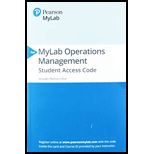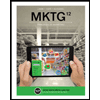
Concept explainers
a)
To determine: Weeks of supply for Company A.
Introduction:
a)
Answer to Problem 6P
Weeks of supply for Company A is 3.85.
Explanation of Solution
Given information:
| Company A | |
| Net revenue | $16,500.00 |
| Cost of sales | $13,500.00 |
| Inventory | $1,000.00 |
| Total assets | $8,600.00 |
Formula to calculate week of supply:
Calculation of week of supply:
Sale per week is calculated by dividing the annual sales with the number of weeks in a year. Annual sales $13,500 is divided with 52 which give $259.60.
Week of supply is calculated by dividing inventory with sales per week. The inventory $1,000 is divided with $259.60 yields 3.85 as weeks of supply for company A.
Hence, weeks of supply for Company A is 3.85.
b)
To determine: Percentage of assets committed to inventory in Company A.
b)
Answer to Problem 6P
Answer: 11.63% of total assets of Company A is committed to inventory.
Explanation of Solution
Given information:
| Company A | |
| Net revenue | $16,500.00 |
| Cost of sales | $13,500.00 |
| Inventory | $1,000.00 |
| Total assets | $8,600.00 |
Formula to inventory investment:
Calculation of inventory investment:
Percentage of assets committed to inventory can be calculated by computing inventory investment. Inventory investment is calculated by dividing inventory with the total assets. The inventory $1,000 is divided with total assets $8,600 which yields 11.63% of assets of Company A is committed to inventory.
Hence, 11.63% of total assets of Company A are committed to inventory.
c)
To determine: Inventory turnover of Company A.
c)
Answer to Problem 6P
The turnover of Company B is 13.5.
Explanation of Solution
Given information:
| Company A | |
| Net revenue | $16,500.00 |
| Cost of sales | $13,500.00 |
| Inventory | $1,000.00 |
| Total assets | $8,600.00 |
Formula to calculate turnover:
Calculation of turnover:
The turnover is calculated by dividing cost of sales with inventory. The cost of sales $13,500 is divided with inventory $1,000 which yields turnover of 13.5 for company A.
Hence, the turnover of Company A is 13.5.
d)
To Compare: Performance of Company A with industry leaders.
d)
Answer to Problem 6P
Company A needs to improve its performance.
Explanation of Solution
Given information:
| Company A | Company B | |
| Net revenue | $16,500.00 | $27,500.00 |
| Cost of sales | $13,500.00 | $21,500.00 |
| Inventory | $1,000.00 | $1,250.00 |
| Total assets | $8,600.00 | $16,600.00 |
Formula:
Comparison calculation of turnover and inventory investment:
| Company A | Company B | |
| Net revenue | $16,500.00 | $27,500.00 |
| Cost of sales | $13,500.00 | $21,500.00 |
| Inventory | $1,000.00 | $1,250.00 |
| Total assets | $8,600.00 | $16,600.00 |
| Turn over | 13.5 | 17.2 |
| Inventory investment | 11.63% | 7.53% |
From the above calculation of turnover and inventory investment it can be inferred that Company A has a turnover of 13.5 when the turnover of Company B is 17.2. The inventory investment of Company A is 11.63% when the Company B has 7.53%.
In both the aspects, Company B is far ahead of Company A. So, the performance of Company A has to be better and the management team must look into the aspects to improve the performance.
Hence, Company A needs to improve its performance.
Want to see more full solutions like this?
Chapter 11 Solutions
Pearson eText Principles of Operations Management: Sustainability and Supply Chain Management -- Instant Access (Pearson+)
- Please help with only the one I circled! I solved the others :)arrow_forwardOsprey Sports stocks everything that a musky fisherman could want in the Great North Woods. A particular musky lure has been very popular with local fishermen as well as those who buy lures on the Internet from Osprey Sports. The cost to place orders with the supplier is $40/order; the demand averages 3 lures per day, with a standard deviation of 1 lure; and the inventory holding cost is $1.00/lure/year. The lead time form the supplier is 10 days, with a standard deviation of 2 days. It is important to maintain a 97 percent cycle-service level to properly balance service with inventory holding costs. Osprey Sports is open 350 days a year to allow the owners the opportunity to fish for muskies during the prime season. The owners want to use a continuous review inventory system for this item. Refer to the standard normal table for z-values. a. What order quantity should be used? lures. (Enter your response rounded to the nearest whole number.)arrow_forwardIn a P system, the lead time for a box of weed-killer is two weeks and the review period is one week. Demand during the protection interval averages 262 boxes, with a standard deviation of demand during the protection interval of 40 boxes. a. What is the cycle-service level when the target inventory is set at 350 boxes? Refer to the standard normal table as needed. The cycle-service level is ☐ %. (Enter your response rounded to two decimal places.)arrow_forward
- Oakwood Hospital is considering using ABC analysis to classify laboratory SKUs into three categories: those that will be delivered daily from their supplier (Class A items), those that will be controlled using a continuous review system (B items), and those that will be held in a two bin system (C items). The following table shows the annual dollar usage for a sample of eight SKUs. Fill in the blanks for annual dollar usage below. (Enter your responses rounded to the mearest whole number.) Annual SKU Unit Value Demand (units) Dollar Usage 1 $1.50 200 2 $0.02 120,000 $ 3 $1.00 40,000 $ 4 $0.02 1,200 5 $4.50 700 6 $0.20 60,000 7 $0.90 350 8 $0.45 80arrow_forwardA part is produced in lots of 1,000 units. It is assembled from 2 components worth $30 total. The value added in production (for labor and variable overhead) is $30 per unit, bringing total costs per completed unit to $60 The average lead time for the part is 7 weeks and annual demand is 3800 units, based on 50 business weeks per year. Part 2 a. How many units of the part are held, on average, in cycle inventory? enter your response here unitsarrow_forwardassume the initial inventory has no holding cost in the first period and back orders are not permitted. Allocating production capacity to meet demand at a minimum cost using the transportation method. What is the total cost? ENTER your response is a whole number (answer is not $17,000. That was INCORRECT)arrow_forward
- Regular Period Time Overtime Supply Available puewag Subcontract Forecast 40 15 15 40 2 35 40 28 15 15 20 15 22 65 60 Initial inventory Regular-time cost per unit Overtime cost per unit Subcontract cost per unit 20 units $100 $150 $200 Carrying cost per unit per month 84arrow_forwardassume that the initial inventory has no holding cost in the first period, and back orders are not permitted. Allocating production capacity to meet demand at a minimum cost using the transportation method. The total cost is? (enter as whole number)arrow_forwardThe S&OP team at Kansas Furniture, led by David Angelow, has received estimates of demand requirements as shown in the table. Assuming one-time stockout costs for lost sales of $125 per unit, inventory carrying costs of $30 per unit per month, and zero beginning and ending inventory, evaluate the following plan on an incremental cost basis: Plan B: Vary the workforce to produce the prior month's demand. Demand was 1,300 units in June. The cost of hiring additional workers is $35 per unit produced. The cost of layoffs is $60 per unit cut back. (Enter all responses as whole numbers.) Note: Both hiring and layoff costs are incurred in the month of the change (i.e., going from production of 1,300 in July to 1300 in August requires a layoff (and related costs) of 0 units in August). Hire Month 1 July Demand 1300 Production (Units) Layoff (Units) Ending Inventory Stockouts (Units) 2 August 1150 3 September 1100 4 October 1600 5 November 1900 6 December 1900arrow_forward
- The S&OP team at Kansas Furniture, led by David Angelow, has received estimates of demand requirements as shown in the table. Assuming one-time stockout costs for lost sales of $100 per unit, inventory carrying costs of $20 per unit per month, and zero beginning and ending inventory, evaluate the following plan on an incremental cost basis: Plan A: Produce at a steady rate (equal to minimum requirements) of 1,100 units per month and subcontract additional units at a $65 per unit premium cost. Subcontracting capacity is limited to 800 units per month. (Enter all responses as whole numbers). Ending Month Demand Production Inventory Subcontract (Units) 1 July 1300 1,100 0 2 August 1150 1,100 0 3 September 1100 1,100 0 4 October 1600 1,100 0 5 November 1900 1,100 0 6 December 1200 1,100 0arrow_forwardPlease help me expand upon my research even more in detail please. Need help added more to mine from the photos please. Not sure what more I can add.arrow_forwardHow can HR proactively help ensure that other departments are operating in a legally acceptable manner? Answers Deliver interdepartmental training on legal compliance and requirements. Discuss potential sources of risk with an attorney and create a plan to respond to lawsuits. Ensure that all HR members are watching the conduct of other departments and report infractions to the head of HR. Record improper conduct from various employees throughout the organization and pursue disciplinary measures.arrow_forward
 Purchasing and Supply Chain ManagementOperations ManagementISBN:9781285869681Author:Robert M. Monczka, Robert B. Handfield, Larry C. Giunipero, James L. PattersonPublisher:Cengage Learning
Purchasing and Supply Chain ManagementOperations ManagementISBN:9781285869681Author:Robert M. Monczka, Robert B. Handfield, Larry C. Giunipero, James L. PattersonPublisher:Cengage Learning Contemporary MarketingMarketingISBN:9780357033777Author:Louis E. Boone, David L. KurtzPublisher:Cengage Learning
Contemporary MarketingMarketingISBN:9780357033777Author:Louis E. Boone, David L. KurtzPublisher:Cengage Learning- MarketingMarketingISBN:9780357033791Author:Pride, William MPublisher:South Western Educational Publishing






